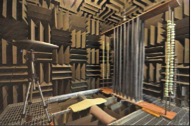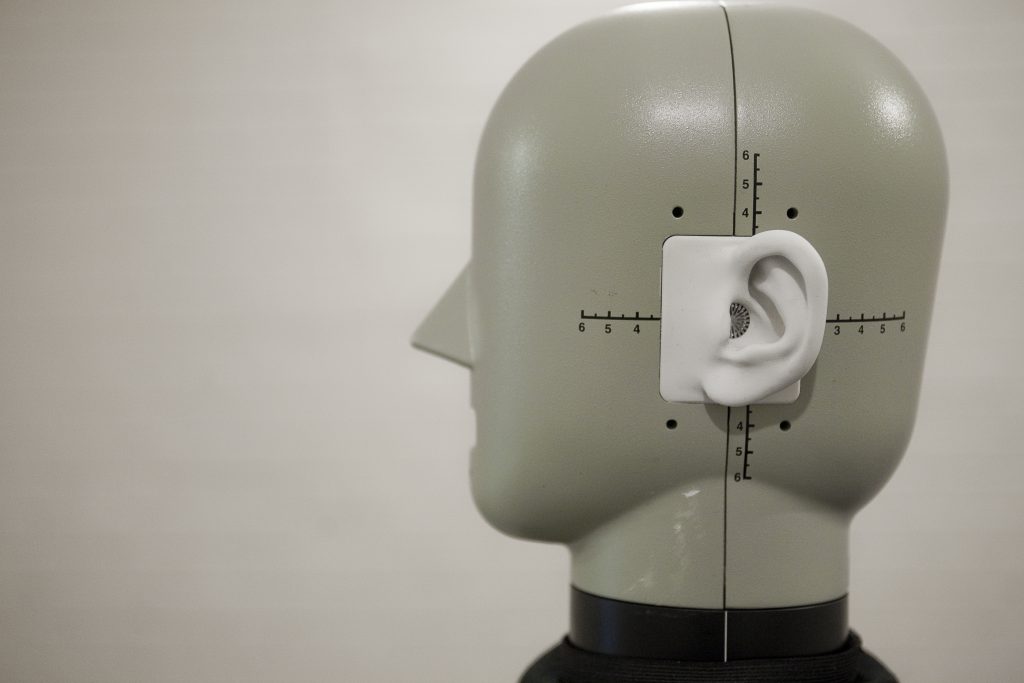Sonic crystal noise barriers
Details of EPSRC grant
Research team: Anton Krynkin, Olga Umnova, A.Y.B. Chong (OU), S.Taherzadeh (OU), K.Attenborough (OU)
Summary from final report
Outdoor noise barriers are used to reduce noise disturbance from fixed industrial plant, from aircraft ground operations and from roads. Recent years have seen a growing interest in the potential for use of sonic crystals as noise barriers. Sonic crystals take their name from the analogous effects of photonic crystals on light.
They consist of periodic arrays of circular cylinders and are known to give high attenuation at selective frequencies as a consequence of multiple scattering. The frequencies of highest attenuation can be found by assuming that an integer number of half wavelengths fits the distance between the scatterers. Additional attenuation bands may be achieved if the array is composed of resonant elements instead of solid cylinders. Possibly the main advantage of sonic crystals (SCs) is that by varying the distance between the cylinders and the design of the resonant elements it is possible to attain peaks of attenuation in a certain range of frequencies. Another advantage of an SC barrier would be its relative optical transparency. Another would be its relative permeability to wind, thus reducing the effects of barrier induced turbulence and wind-gradient enhancement. In principle, if SC barriers are used as highway noise barriers on both sides of a road, there should be less reverberation than between solid barriers. The appearance of an SC barrier might also have a rather positive aesthetic impact. After all, the interest in using SCs as barriers started with the discovery that a ‘sculpture’ consisting of vertical parallel cylinders acted as a sound barrier. Various possible designs of SC barriers have been considered. In addition to ‘conventional’ vertical circular cylinder arrays, the acoustical performance of horizontal cylinders arrays above a reflecting plane as well as arrays of elastic shells and composite resonant elements was investigated both analytically/numerically and through laboratory measurements. The optimisation of the design of SC arrays making use of acoustic lens effects and resonances was investigated. The outdoor performance of vertical cylinder arrays of resonant elements in configurations suitable for road traffic noise will be tested and compared with that of a simple barrier in various wind conditions.

Dispersion diagram of doubly-periodic array of elastic shells showing low frequency bandgaps

Array of elastic shells installed in an anechoic chamber (Open University, UK).
Journal publications
- A.Krynkin, O.Umnova, A.Y.B.Chong, S.Taherzadeh, K.Attenborough “Predictions and measurements of sound transmission through a periodic array of elastic shells in air”, Journal of the Acoustical Society of America, 128, 3496-3506 (2010)
- A.Krynkin, O.Umnova, A.Y.B.Chong, S.Taherzadeh, K.Attenborough, “Scattering by coupled resonating elements in air”, Journal of Physics D: Applied Physics, 44, 125501 (2011).
- A.Krynkin, O.Umnova, J.V. Sanchez-Perez, A.Y.B.Chong, S.Taherzadeh, K.Attenborough “Acoustic insertion loss due to two dimensional periodic arrays of circular cylinders parallel to a nearby surface” Journal of the Acoustical Society of America, 130, 3736-3745 (2011).
- V. Romero-Garcia, A.Krynkin, L.M. Garcia-Raffi, O.Umnova, J.V. Sanchez-Perez “Multi-resonant scatterers in sonic crystals: Locally multi-resonant acoustic metamaterial” Journal of Sound and Vibration, 332, 184-198 (2013).
- A.Krynkin, O.Umnova, S.Taherzadeh, K.Attenborough “Analytical approximations for low frequency band gaps in periodic arrays of elastic shells” Journal of the Acoustical Society of America, 133, 781-791 (2013).
- O.Umnova, A.Krynkin, A.Y.B.Chong, S.Taherzadeh, K.Attenborough “Comparisons of two effective medium approaches for predicting sound scattering by periodic arrays of elastic shells” Journal of the Acoustical Society of America, 134, 3619-3630 (2013).
